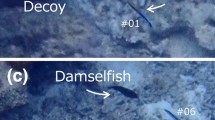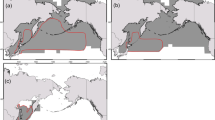Abstract
In two laboratory experiments we tested juvenile yellow perch, Perca flavescens, for behavioural responses to alarm cues of injured conspecifics and several prey guild members: adult perch, Iowa darters, Etheostoma exile and spottail shiners, Notropis hudsonius. Spottail shiners are phylogenetically distant to yellow perch whereas Iowa darters and perch are both members of the Family Percidae. Groups of juvenile yellow perch increased shoal cohesion and movement towards the substrate after detecting conspecific alarm cues when compared to cues of injured swordtails, Xiphophorus helleri, a species phylogenetically distant from perch. Individual juvenile perch increased shelter use and froze more when exposed to chemical alarm cues from both juvenile and adult perch, shiners and darters compared to exposure to injured swordtail cues or distilled water. The response to cues of darters may indicate that alarm cues are evolutionarily conserved within percid fishes or that perch had learned to recognize darter cues. The response to spot tail shiners likely represents learned recognition of the cues of a prey guild member.
Similar content being viewed by others
References cited
Berejikian, B.A., R.J.F. Smith, E.P. Tezak, S.L. Schroder & C.M. Knudson. 1999. Chemical alarm signals and complex hatchery rearing habitats affect antipredator behavior and survival of chinook salmon (Oncorhynchus tshawytscha) juveniles. Can. J. Fish. Aquat. Sci. 56: 830-838.
Brown, G.E. & J.-G.J. Godin. 1997. Anti-predator responses to conspecific and heterospecific skin extracts by threespine sticklebacks: Alarm pheromones revisited. Behaviour 134: 1123-1134.
Brown, G.E. & J.-G.J. Godin. 1999. Chemical alarm signals in wild Trinidadian guppies (Poecilia reticulata). Can. J. Zool. 77: 562-570.
Brown, G.E. & R.J.F. Smith. 1997. Conspecific skin extracts elicit anti-predator responses in juvenile rainbow trout (Oncoryhnchus mykiss). Can. J. Zool. 75: 1916-1922.
Brown, G.E. & S. Brennan. 2000. Chemical alarm signals in juvenile green sunfish (Lepomis cyanellus, Centrachidae). Copeia 2000: 1079-1082.
Brown, G.E., J.C. Adrian, E. Smyth, H. Leet & S. Brennan. 2000. Ostariophysan alarm pheromones: Laboratory and field tests of the functional significance of nitrogen oxides. J. Chem. Ecol. 26: 139-154.
Bryer, P.J., R.S. Mirza & D.P. Chivers. 2001. Chemosensory assessment of predation risk by slimy sculpins (Cottus cognatus): Responses to alarm, disturbance and predator cues. J. Chem. Ecol. 27: 533-546.
Chivers, D.P. & R.J.F. Smith. 1994. Intra-and interspecific avoidance of areas marked with skin extract from brook sticklebacks (Culaea inconstans) in a natural habitat. J. Chem. Ecol. 20: 1517-1524.
Chivers, D.P. & R.J.F. Smith. 1998. Chemical alarm signalling in aquatic predator-prey systems: A review and prospectus. Écoscience 5: 338-352.
Chivers, D.P., B.D. Wisenden & R.J.F. Smith. 1995. The role of experience in the response of fathead minnows (Pimephales promelas) to skin extract of Iowa darters (Etheostoma exile). Behaviour 132: 665-674.
Chivers, D.P., M.H. Puttlitz & A.R. Blaustein. 2000. Chemical alarm signaling by reticulate sculpins, Cottus perplexus. Env. Biol. Fish. 57: 347-352.
Commens, A.M. & A. Mathis. 1999. Alarm pheromones of rainbow darters: Responses to skin extracts of conspecifics and congeners. J. Fish Biol. 55: 1359-1362.
Frisch, K. von. 1938. Zur psychologie des fisch-schwarmes. Naturwissenschaften 26: 601-606.
García, C., E. Rolán-Alvarez & L. Sánchez. 1992. Alarm reaction and alert state in Gambusia affinis (Pisces, Poeciliidae) in response to chemical stimuli from injured conspecifics. J. Ethol. 10: 41-46.
Hugie, D.M., P.L. Thuringer & R.J.F. Smith. 1991. The response of the tidepool sculpin, Oligocottus maculosus, to chemical stimuli from injured conspecifics, alarm signalling in cottidae (Pisces). Ethology 89: 322-334.
Kats, L.B. & L.M. Dill. 1998. The scent of death: Chemosensory assessment of predation risk by prey animals. Écoscience 5: 361-394.
Lima, S.L. & L.M. Dill. 1990. Behavioural decisions made under the risk of predation: A review and prospectus. Can. J. Zool. 68: 619-640.
Magurran, A.E., P.W. Irving & P.A. Henderson. 1996. Is there a fish alarm pheromone? A wild study and critique. Proc. Roy. Soc. Lond. B 263: 1551-1556.
Maniak, P.J., R.D. Lossing & P.W. Sorensen. 2000. Injured Eurasian ruffe, Gymnocephalus cernuus, release an alarm pheromone that could be used to control their dispersal. J. Great Lakes Res. 26: 183-195.
Mathis, A. & R.J.F. Smith 1993a. Chemical alarm signals increase the survival time of fathead minnows (Pimephales promelas) during encounters with northern pike (Esox lucius). Behav. Ecol. 4: 260-265.
Mathis, A. & R.J.F. Smith. 1993b. Intraspecific and crosssuperorder responses to chemical alarm signals by brook stickleback. Ecology 74: 2395-2404.
Mirza, R.S. & D.P. Chivers. 2000. Predator-recognition training enhances survival of brook trout: Evidence from laboratory and field enclosure studies. Can. J. Zool. 78: 2198-2208.
Mirza, R.S. & D.P. Chivers. 2001a. Are chemical alarm cues conserved within salmonid fishes? J. Chem. Ecol. 27: 1641-1655.
Mirza, R.S. & D.P. Chivers. 2001b. Chemical alarm signals enhance survival of brook charr (Salvelinus fontinalis) during encounters with chain pickerel (Esox niger). Ethology 107: 989-1006.
Mirza, R.S. & D.P. Chivers. 2001c. Do chemical alarm signals enhance survival of aquatic vertebrates? An analysis of the current research paradigm. pp. 19-26, In: A. Marchlewska-Koj, J.J. Lepri & D. Müller-Schwarze (ed.) Chemical Signals in Vertebrates, Volume 9. Plenum Press, New York.
Mirza, R.S. & D.P. Chivers. 2002. Brook charr (Salvelinus fontinalis) can differentiate chemical alarm cues produced by different size classes of conspecifics. J. Chem. Ecol. 28: 555-564.
Mirza, R.S., J.J. Scott & D.P. Chivers. 2001. Differential responses of male and female red swordtails to chemical alarm cues. J. Fish Biol. 59: 716-728.
Nelson, J.S. 1994. Fishes of the World, 3rd edn. John Wiley and Sons, New York, 600 pp.
Nordell, S.E. 1998. The response of female guppies, Poecilia reticulata, to chemical stimuli from injured conspecifics. Env. Biol. Fish. 51: 331-338.
Pfeiffer, W. 1977. The distribution of fright reaction and alarm substance cells in fishes. Copeia 1977: 653-665.
Reed, J.R. 1969. Alarm substances and fright reactions in some fishes from the southeastern United States. Trans. Amer. Fish. Soc. 4: 664-668.
Rehnberg, B.G. & R.J.F. Smith. 1987. The reaction of pearl dace (Pices, Cyprinidae) to alarm substance: Time-course of behavior, brain amines, and stress physiology. Can. J. Zool. 65: 2916-2921.
Schutz, F. 1956. Vergleichende Untersuchungen über die Schreckreaktion bei Fischen und deren Verbreitung. Z. Vergl. Physiol. 38: 84-135.
Scott, W.B. & E.J. Crossman. 1979. Freshwater Fishes of Canada. Fish. Res. Board Can. Bull. 184: 966 pp.
Siegel, S. & N.J. Castellan. 1988. Nonparametric Statistics for the Behavioral Sciences 2nd edn. McGraw-Hill, New York. 399 pp.
Smith, R.J.F. 1979. Alarm reaction of Iowa and johnny darters (Etheostoma, Percidae, Pisces) to chemicals from injured conspecifics. Can. J. Zool. 57: 1278-1282.
Smith, R.J.F. 1982. Reaction of Percina nigrofasciata, Ammocrypta beani and Etheostoma swaini (Percidae, Pisces) to conspecific and intergeneric skin extracts. Can. J. Zool. 60: 1067-1072.
Smith, R.J.F. 1992. Alarm signals in fishes. Rev. Fish Biol. Fish. 2: 33-63.
Smith, R.J.F. 1997. Does one result trump all others? A response to Magurran, Irving and Henderson. Proc. Roy. Soc. Lond. B. 264: 445-450.
Smith R.J.F., B.J. Lawrence & M.J. Smith. 1991. Cross-reaction to skin extract between two gobies, Asterropteryx semipunctatus and Brachygobius sabanus. J. Chem. Ecol. 17: 2253-2259.
Wisenden, B.D. & R.C. Sargent. 1997. Antipredator behaviour and suppressed aggression by convict cichlids in response to injury-released chemical cues of conspecifics but not to those of an allopatric heterospecific. Ethology 103: 283-291.
Wisenden, B.D., A. Cline & T.C. Sparkes. 1999. Survival benefit to antipredator behaviour in the amphipod Gammarus minus (Crustacea: Amphipoda) in response to injury-released chemical cues from conspecifics and heterospecifics. Ethology 105: 407-414.
Wisenden, B.D., D.P. Chivers, G.E. Brown & R.J.F. Smith. 1995. The role of experience in risk assessment: Avoidance of areas chemically labelled with fathead minnow alarm pheromone by conspecifics and heterospecifics. Écoscience 2: 116-122.
Author information
Authors and Affiliations
Rights and permissions
About this article
Cite this article
Mirza, R.S., Fisher, S.A. & Chivers, D.P. Assessment of Predation Risk by Juvenile Yellow Perch, Perca flavescens: Responses to Alarm Cues from Conspecifics and Prey Guild Members. Environmental Biology of Fishes 66, 321–327 (2003). https://doi.org/10.1023/A:1023966320018
Issue Date:
DOI: https://doi.org/10.1023/A:1023966320018




